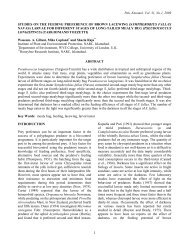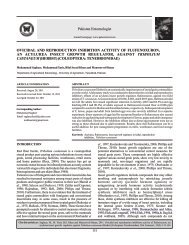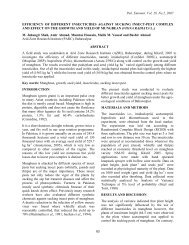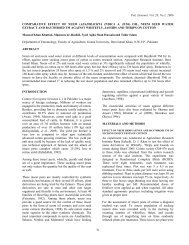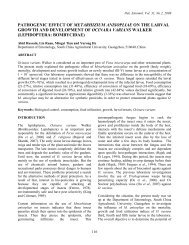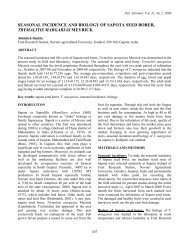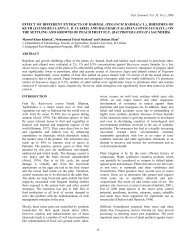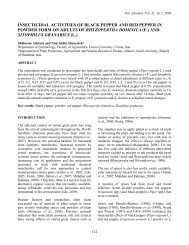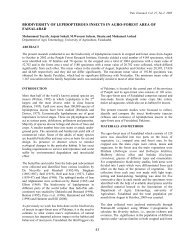growth regulatory effect of extracts of azadirachta indica, curcuma ...
growth regulatory effect of extracts of azadirachta indica, curcuma ...
growth regulatory effect of extracts of azadirachta indica, curcuma ...
You also want an ePaper? Increase the reach of your titles
YUMPU automatically turns print PDFs into web optimized ePapers that Google loves.
Pakistan Entomologist<br />
Journal homepage: www.pakentomol.com<br />
GROWTH REGULATORY EFFECT OF EXTRACTS OF AZADIRACHTA<br />
INDICA, CURCUMA LONGA, NIGELLA SATIVA AND PIPER NIGRUM ON<br />
DEVELOPMENTAL STAGES OF TROGODERMA GRANARIUM (EVERTS)<br />
(COLEOPTERA: DERMESTIDAE)<br />
* Mansoor-ul-Hasan , Muhammad Sagheer , Qurban Ali , Jamshaid Iqbal and Muhammad Shahbaz<br />
1 1 1 2 3<br />
1<br />
Department <strong>of</strong> Agricultural Entomology, University <strong>of</strong> Agriculture, Faisalabad, Pakistan<br />
2<br />
Assistant Director, Department <strong>of</strong> Pest Warning and Quality Control <strong>of</strong> Pesticides, Bhakkar<br />
3<br />
Assistant Director, Department <strong>of</strong> Pest Warning and Quality Control <strong>of</strong> Pesticides, Lahore<br />
ARTICLE INFORMATION<br />
Received: August 10, 2011<br />
Received in revised form: December 1, 2012<br />
Accepted: December 20, 2012<br />
*Corresponding Author:<br />
Mansoor ul Hasan<br />
Email: mansoorsahi2000@yahoo.com<br />
ABSTRACT<br />
The <strong>extracts</strong> from four medicinal plants viz., Azadirachta <strong>indica</strong>, Curcuma longa, Nigella<br />
sativa and Piper nigrum were assessed at 5, 10, 15 and 20% concentration against khapra<br />
beetle, Trogoderma granarium (Everts) for their potential to protect stored-wheat grains in<br />
term <strong>of</strong> their toxicity and <strong>effect</strong> on progeny development. The highest mean mortality<br />
(14.36%) was observed in case <strong>of</strong> A. <strong>indica</strong>, whereas, the lowest mortality (6.78%) was found<br />
in P. nigrum after 30 days <strong>of</strong> treatment. Pupation was highest (46.66%) in case <strong>of</strong> P. nigrum<br />
extract, while the lowest one (27.11%) in C. longa after sixty days <strong>of</strong> treatment. Adult<br />
emergence was observed in descending order; P. nigrum > N. sativa > A. <strong>indica</strong> > C. longa<br />
whereas, the highest in control (71.39%).The highest F<br />
1<br />
progeny was found in control<br />
treatment, followed by N. sativa, P. nigrum, A. <strong>indica</strong> and C. longa, respectively. The <strong>extracts</strong><br />
from these plants caused significant mortality <strong>of</strong> T. granarium, reduced its reproductive<br />
potential and deterred the larvae from feeding on wheat grains. Therefore, these plant <strong>extracts</strong><br />
can serve as the foundation for development <strong>of</strong> new botanical insecticides.<br />
Keywords:<br />
Plant <strong>extracts</strong>, T. granarium, <strong>growth</strong> <strong>regulatory</strong> <strong>effect</strong>, mortality, botanicals<br />
INTRODUCTION<br />
granarium have been reported to range from 0.2-2.9% over a<br />
period <strong>of</strong> 1-10.5 months in Pakistan (Irshad et al., 1988).<br />
The storage <strong>of</strong> grains and other food products in respect to Severe infestation by khapra beetle makes grain unpalatable<br />
insect infestation is a serious problem throughout the world. and unmarketable due to depletion <strong>of</strong> specific nutrients (Jood<br />
Annual post-harvest losses resulting from insect damage, and Kapoor, 1994).<br />
microbial deterioration and other factors are estimated to be In Pakistan, T. granarium has been observed to have<br />
10-25% <strong>of</strong> production the worldwide (Matthews, 1993). resistance against phosphine due to substandard techniques <strong>of</strong><br />
Among various contributing factors to the huge losses, insect fumigation (Irshad and Iqbal, 1994). Sharma and Kalra<br />
pests are a major problem in stored grain throughout the world (1998) also reported phosphine resistance to different stages<br />
because they reduce the quality and quantity <strong>of</strong> grains <strong>of</strong> T. granarium.<br />
(Madrid et al., 1990; Sinha and Watters, 1985). In Pakistan, it For the control <strong>of</strong> insect pests, the use <strong>of</strong> insecticides has been<br />
has been estimated that 5-7% loss <strong>of</strong> food grain occurs due to the main method <strong>of</strong> grain protection because <strong>of</strong> being simplest<br />
the infestation caused by storage insect pests (Jilani and and cost <strong>effect</strong>ive (Hidalgo et al., 1998), but the wide spread<br />
Ahmad, 1982).<br />
use <strong>of</strong> these pesticides have significant drawbacks including;<br />
Among the insects attacking stored products, Trogoderma development <strong>of</strong> insecticide resistant strains, increased cost,<br />
granarium (Everts) which is locally known as Khapra beetle, environmental pollution, handling hazards, residues<br />
is one <strong>of</strong> the most notorious pest <strong>of</strong> stored grains (Banks, contamination and lethal <strong>effect</strong>s on non-target organisms<br />
1977; Hill, 1983) and has attracted the attention <strong>of</strong> many (Zettler and Cuperus, 1990; Tapondjou et al., 2002).<br />
scientists not only because it can easily be manipulated but Plant origin products are getting greater attention as<br />
also because <strong>of</strong> its economic importance. Losses caused by T. prophylactic measures against stored-product pests, mainly<br />
Cite this article as:<br />
Mansoor-ul-Hasan, M. Sagheer, Q. Ali, J. Iqbal and M. Shahbaz, 2012. Growth <strong>regulatory</strong> <strong>effect</strong> <strong>of</strong> <strong>extracts</strong> <strong>of</strong> Azadirachta <strong>indica</strong>,<br />
Curcuma longa, Nigella sativa and Piper nigrum on developmental stages <strong>of</strong> Trogoderma granarium (Everts) (Coleoptera:<br />
Dermestidae). Pak. Entomol., 34(2): 111-115.<br />
111 77
Mansoor-ul-Hasan et al. / Pakistan Entomologist 2012, 34(2): 111-115<br />
because <strong>of</strong> their safety to non-target organisms (Jood et al., minutes to allow solvent to evaporate before the start <strong>of</strong><br />
1996). Capsicum has also proven its insecticidal activity bioassay. These treated grains were transferred in plastic jars.<br />
against rice grain pest, Sitotroga cerealella (Olivier) (Prakash One jar was kept as control in each treatment containing<br />
and Rao, 2006). Su (1983) found that acetone <strong>extracts</strong> <strong>of</strong><br />
rd<br />
untreated grains. Thirty larvae <strong>of</strong> 3 instar were separately<br />
Piper nigrum L. and the Hexane extract <strong>of</strong> dry fruit <strong>of</strong> Piper transferred to plastic jars. After the release <strong>of</strong> larvae, the<br />
guineense were toxic to four species <strong>of</strong> stored-product insects. mouth <strong>of</strong> jars was covered with muslin cloth and kept at<br />
The essential oil <strong>of</strong> garlic has been found toxic against 30±2ºC and 65±5 % RH. The data regarding mortality (%)<br />
Tribolium castaneum (Herbst) and Sitophilus zeamais was recorded 5, 10, 15 and 30 day after the treatment. The data<br />
Motschulsky (Ho et al., 1996). Powder <strong>of</strong> Melia azadiracha regarding to larval development (days), pupation and adult<br />
bark showed excellent repellency against Rhyzopertha emergence was also recorded 60 day <strong>of</strong> after insect release.<br />
dominica (F.) (Khan and Marwat, 2003). Oil obtained from Completely Randomized Design with 5 treatments <strong>of</strong> each 3<br />
Peganum harmala seed has insecticidal activity against T. replicates was made for the biological tests. The corrected<br />
castaneum larvae and adults (Jbilou et al., 2008).<br />
mortality for each treatment was calculated by Abbott's<br />
Efforts were made in the present study to evaluate the lethal formula (Abbott, 1925). The surviving individuals from the<br />
and <strong>growth</strong> <strong>regulatory</strong> <strong>effect</strong>s <strong>of</strong> <strong>extracts</strong> <strong>of</strong> Azadirachta adult bioassay were transferred into the new clean jars<br />
<strong>indica</strong>, Curcuma longa, Nigella sativa and Piper nigrum containing 60 mg <strong>of</strong> sterilized wheat and the data <strong>of</strong><br />
against T. granarium.<br />
population <strong>growth</strong> was recorded after 60 days.<br />
MATERIALS AND METHODS<br />
Statistical analysis<br />
Culture <strong>of</strong> T. granarium<br />
Abbott's formula (Abbott, 1925) was used for corrected<br />
mortality and data obtained was subjected to analysis <strong>of</strong><br />
Heterogeneous population <strong>of</strong> T. granarium was collected variance (ANOVA) using proper statistical package. The<br />
from various godowns <strong>of</strong> Punjab Food Department, means were separated by Tukey's HSD test at 5% level <strong>of</strong><br />
Faisalabad, for rearing the test insect population in laboratory. significance.<br />
The insects were retained in plastic jars <strong>of</strong> 1000 ml capacity in<br />
the laboratory for two months, to get homogenous population RESULTS AND DISCUSSION<br />
<strong>of</strong> the test insect. T. granarium adults were separated and<br />
retained in plastic jars in a medium <strong>of</strong> wheat grains for a The mean corrected mortality (%) for all tested plant <strong>extracts</strong><br />
period <strong>of</strong> 3 days (72 hours) at a temperature <strong>of</strong> 30±2ºC and at various concentrations (Fig. 1) showed statically<br />
65±5% R.H. in an incubator. After that insects were taken out significant differences. The highest concentration (20%) gave<br />
from these plastic jars containing the media (wheat grains) the highest percent mean mortality (15.39%) followed by<br />
with sufficient number <strong>of</strong> eggs laid by females. Progeny with 15% concentration (11.94%), while 10% and 5%<br />
same size and age, which was obtained from these rearing concentrations caused 9.08 and 5.92% mean mortality against<br />
plastic jars, was kept for another period <strong>of</strong> one week before larvae <strong>of</strong> T. granarium, respectively.<br />
their use in biological tests.<br />
18<br />
16<br />
Collection <strong>of</strong> plant materials<br />
14<br />
12<br />
Fresh leaves <strong>of</strong> A. <strong>indica</strong>, P. nigrum and fruits <strong>of</strong> C. longa and 10<br />
8<br />
Nigella sativa were collected from the Botanical Garden,<br />
6<br />
University <strong>of</strong> Agriculture and local market <strong>of</strong> Faisalabad, 4<br />
Pakistan.<br />
2<br />
0<br />
Preparation <strong>of</strong> plant <strong>extracts</strong><br />
5 10 15 20<br />
Fig. 1<br />
Concentrations (%)<br />
The plant materials were washed in water and after sun drying Effect <strong>of</strong> various concentrations <strong>of</strong> acetone <strong>extracts</strong> <strong>of</strong> A.<br />
these plant materials were ground to bring these in the form <strong>of</strong> <strong>indica</strong>, C. longa, N. sativa and P. nigrum on mortality <strong>of</strong> T.<br />
powder. Their extraction was done by using Soxhlet's<br />
Extraction Apparatus by dipping 50 mg <strong>of</strong> powder in 250 ml<br />
acetone; following procedure was described by Valladares et<br />
al. (1997) and Ahmad et al. (2006). Chemical <strong>extracts</strong><br />
obtained were kept in clean and air tight lid bottles. The<br />
samples were stored in the refrigerator at 4ºC before their use.<br />
granarium larvae on treated wheat grains.<br />
The results regarding to mortality (Fig. 2) revealed that<br />
exposure time had also significant <strong>effect</strong>. The longest<br />
exposure period (30 days) gave the highest mean mortality<br />
(15.71), followed by 15 days exposure period (11.82%). The<br />
exposure period <strong>of</strong> 5 and 10 days resulted in 8.99 and 5.82%<br />
Bioassay studies <strong>of</strong> plant <strong>extracts</strong> against larvae <strong>of</strong> T. <strong>of</strong> mean mortality in all plants combined analysis.<br />
granarium<br />
The mortality data <strong>of</strong> tested plant <strong>extracts</strong> (Fig. 3) showed that<br />
there were significant differences in the mortalities <strong>of</strong> tested<br />
For mortality bioassay, 60 mg <strong>of</strong> wheat grains was sprayed plant <strong>extracts</strong>. The highest mean mortality (14.36%) was<br />
with 5, 10, 15 and 20% concentration <strong>of</strong> test solution recorded in case <strong>of</strong> A. <strong>indica</strong>, followed by C. longa (11.80%),<br />
uniformly with the help <strong>of</strong> a pipette. Grains were kept for 60 N. sativa (9.39%) and P. nigrum (6.78%), respectively.<br />
112<br />
Moratality (%)
Mortality (%)<br />
18<br />
16<br />
14<br />
12<br />
10<br />
8<br />
6<br />
4<br />
2<br />
0<br />
5 10 15 30<br />
Days<br />
Mansoor-ul-Hasan et al. / Pakistan Entomologist 2012, 34(2): 111-115<br />
in control, followed by 41.12, 37.50, 34.16 and 33.05 at 5, 10,<br />
150 and 20% <strong>of</strong> concentrations, respectively.<br />
Fig. 2<br />
0<br />
Effect <strong>of</strong> exposure period on mortality <strong>of</strong> T. granarium larvae<br />
treated by various concentrations <strong>of</strong> acetone <strong>extracts</strong> <strong>of</strong> A.<br />
<strong>indica</strong>, C. longa, N. sativa and P. nigrum on wheat grains. Fig. 5<br />
18<br />
16<br />
14<br />
12<br />
10<br />
8<br />
6<br />
4<br />
2<br />
0<br />
A. <strong>indica</strong> C. longa N. sativa P. nigrum<br />
Fig. 3<br />
Plants<br />
Effect <strong>of</strong> acetone <strong>extracts</strong> <strong>of</strong> A. <strong>indica</strong>, C. longa, N. sativa and<br />
P. nigrum on mortality <strong>of</strong> T. granarium larvae on treated<br />
wheat grains.<br />
Mortality (%)<br />
The mean value <strong>of</strong> pupation (%) in relation to different<br />
concentrations (Fig. 4) <strong>of</strong> plant <strong>extracts</strong> revealed that all the<br />
concentrations differed significantly except 15 and 20% <strong>of</strong><br />
concentration, which were statistically similar to one another.<br />
The highest pupation (57.50) was observed in control,<br />
followed by 38.05, 33.33, 31.38 and 30.27 at 5, 10, 15 and<br />
20% <strong>of</strong> concentration, respectively.<br />
70<br />
60<br />
50<br />
40<br />
30<br />
20<br />
10<br />
0<br />
5 10 15 20 Control<br />
Fig. 4<br />
Concentrations (%)<br />
Effect <strong>of</strong> various concentrations <strong>of</strong> acetone <strong>extracts</strong> <strong>of</strong> A.<br />
<strong>indica</strong>, C. longa, N. sativa and P. nigrum on mean percent<br />
pupation <strong>of</strong> T. granarium on treated wheat grains.<br />
Pupation (%)<br />
Effect <strong>of</strong> acetone <strong>extracts</strong> <strong>of</strong> A. <strong>indica</strong>, C. longa, N. sativa and<br />
P. nigrum on mean percent pupation <strong>of</strong> T. granarium on<br />
treated wheat grains.<br />
Fig. 6<br />
Effect <strong>of</strong> various concentrations <strong>of</strong> acetone <strong>extracts</strong> <strong>of</strong> A.<br />
<strong>indica</strong>, C. longa, N. sativa and P. nigrum on mean F 1 adult<br />
emergence <strong>of</strong> T. granarium on treated wheat grains.<br />
The mean value <strong>of</strong> F 1 adult's emergence <strong>of</strong> acetone <strong>extracts</strong> <strong>of</strong><br />
A. <strong>indica</strong>, C. longa, N. sativa and P. nigrum (Fig. 7) showed<br />
that all plant <strong>extracts</strong> differed significantly except N. sativa<br />
and P. nigrum, which were statistically at par to each another.<br />
The highest pupation (51.33%) was recorded in case <strong>of</strong> P.<br />
nigrum, followed by N. sativa (48.22%), A. <strong>indica</strong> (41.11%)<br />
and C. longa (33.11%).<br />
Plants<br />
Fig. 7<br />
Effect <strong>of</strong> acetone <strong>extracts</strong> <strong>of</strong> A. <strong>indica</strong>, C. longa, N. sativa and<br />
P. nigrum on mean F 1 adult emergence <strong>of</strong> T. granarium on<br />
treated wheat grains.<br />
The results <strong>of</strong> analysis (Fig. 5) showed that there were The results (Fig. 8) <strong>of</strong> F1<br />
progeny production revealed that the<br />
significantly difference in mean population values <strong>of</strong> tested highest F 1 progeny (198.00) was observed in control,<br />
plant <strong>extracts</strong> except N. sativa and P. nigrum. The highest followed by 160.00, 142.92, 128.92 and 110.83 at 5, 10, 150<br />
pupation (46.66%) was recorded in case <strong>of</strong> P. nigrum, and 20% <strong>of</strong> concentrations, respectively. Relative<br />
followed by N. sativa (44.66%), C. longa (34.00%) and A. <strong>effect</strong>iveness <strong>of</strong> plant <strong>extracts</strong> (Fig. 9) showed that the highest<br />
<strong>indica</strong> (27.11%) respectively.<br />
F 1 progeny (164.80) was recorded in case <strong>of</strong> P. nigrum,<br />
The results regarding emergence <strong>of</strong> F 1 adults (Fig. 6) <strong>indica</strong>ted followed by N. sativa (178.13), C. longa (127.13) and A.<br />
that all the concentrations differed significantly except 15 and <strong>indica</strong> (122.47), respectively.<br />
20%. The highest F 1 adult emergence (71.39%) was observed<br />
113<br />
Pupation (%)<br />
F1 adult emergence<br />
F1 adult emergence<br />
60<br />
50<br />
40<br />
30<br />
20<br />
10<br />
80<br />
70<br />
60<br />
50<br />
40<br />
30<br />
20<br />
10<br />
0<br />
60<br />
50<br />
40<br />
30<br />
20<br />
10<br />
0<br />
A. <strong>indica</strong> C. longa N. sativa P. nigrum<br />
Plants<br />
5 10 15 20 Control<br />
Concentrations (%)<br />
A. <strong>indica</strong> C. longa N. sativa P. nigrum
Mansoor-ul-Hasan et al. / Pakistan Entomologist 2012, 34(2): 111-115<br />
250<br />
REFERENCES<br />
200<br />
Abbott, W.W., 1925. A method <strong>of</strong> computing the <strong>effect</strong>iveness <strong>of</strong><br />
150<br />
insecticides. J. Econ. Entomol., 18: 265-267.<br />
100<br />
Ahmad, U.A.M., S. Zuha, H.H. Nabil, H.H. Bashier, K. Muafi, H.<br />
50<br />
Zhongping and G. Youling, 2006. Evaluation <strong>of</strong> insecticidal<br />
potential <strong>of</strong> aqueous <strong>extracts</strong> from Calotropis procera Ait. against<br />
0<br />
Henosepilachna elaterii Rossi. J. Appl. Sci., 6: 2466-2470.<br />
5 10 15 20 Control<br />
Banks, H.J., 1977. Distribution and establishment <strong>of</strong> Trogoderma<br />
Fig. 8<br />
Concentrations (%)<br />
granarium Everts (Coleoptera: Dermestidae) climatic and other<br />
Effect <strong>of</strong> various concentrations <strong>of</strong> acetone <strong>extracts</strong> <strong>of</strong> A. influences. J. Stored Prod. Res., 13: 183-202.<br />
<strong>indica</strong>, C. longa, N. sativa and P. nigrum on mean F progeny Dwivedi, S.C. and M. Bajaj, 2000. Repellent action <strong>of</strong> seven plant<br />
F1 Progeny<br />
development <strong>of</strong> T. granarium on treated wheat grains.<br />
F1 Progeny<br />
200<br />
150<br />
100<br />
50<br />
0<br />
A. <strong>indica</strong> C. longa N. sativa P. nigrum<br />
Plants<br />
1<br />
<strong>extracts</strong> against T. granarium. (Coleoptera: Dermestidae). Uttar<br />
Pradesh. J. Zool., 20(1): 97-99.<br />
Dwivedi, S.C. and Y. Sharma, 2002. Investigation on repellent<br />
responses <strong>of</strong> khapra beetle: Trogoderma granarium (Coleoptera:<br />
Dermestidae) to five plant species. Indian Biologists.34(2): 55-58.<br />
Hidalgo, E., D. Moore and L.E. Patourel, 1998. The <strong>effect</strong> <strong>of</strong><br />
different formulations <strong>of</strong> Beauveria bassiana on Sitophilus<br />
zeamais in stored maize. J. Stored Prod. Res., 34: 171-179.<br />
Hill, P., 1983. Agricultural Insect Pests <strong>of</strong> the Tropics and their<br />
Control. Cambridge Univ Press, pp. 746.<br />
Ho, S.H., L. Koh, Y. Ma, Y. Huang and K.Y. Sim, 1996. The oil <strong>of</strong><br />
garlic, Allium sativum L. (Amaryllidaceae), as a potential grain<br />
protectant against Tribolium castaneum (Herbst) and Sitophilus<br />
Fig. 9<br />
zeamais Motsch. Post Harvest J. Biol. Technol., 9: 41-48.<br />
Effect <strong>of</strong> various concentrations <strong>of</strong> acetone <strong>extracts</strong> <strong>of</strong> A.<br />
Irshad, M. and J. Iqbal, 1994. Phosphine resistance in important<br />
<strong>indica</strong>, C. longa, N. sativa and P. nigrum on mean F1 progeny stored grain insect pests in Pakistan. Pak. J. Zool., 26: 347-350.<br />
development <strong>of</strong> T. granarium on treated wheat grains.<br />
Irshad, M., A. Khan and U.K. Baloch, 1988. Losses in wheat in<br />
public sector storages in Rawalpindi region during 1984-85. Pak.<br />
The present findings are inconsistent to the findings <strong>of</strong> J. Agri. Res., 9: 136-140.<br />
Odeyemi (1991) who tested the potency <strong>of</strong> groundnut, Jbilou, R. and F. Sayah, 2008. Effects <strong>of</strong> Pegnum harmala<br />
coconut and the African palm oils admixed with decorticated (Zygophyllaceae) seed <strong>extracts</strong> on the development <strong>of</strong> Tribolium<br />
groundnut seeds. There was a significant reduction in adult castaneum (Coleoptera: Tenebrionidae). Int. J. Trop. Insect Sci.,<br />
27: 199-209.<br />
emergence, adult mortality and larval mortality. As the<br />
Jilani, G. and H. Ahmad, 1982. Safe storage <strong>of</strong> wheat at farm<br />
concentration increased <strong>of</strong> each oil and seed damage and level. Progressive Farming, 2: 11-15.<br />
weight loss <strong>of</strong> infested groundnut seeds were also decreased. Jood, S. and A.C. Kapoor, 1994. Vitamin contents <strong>of</strong> cereal grains as<br />
In recent past some indigenous plants have been reported to affected by storage and insect infestation. Pl. Foods Human Nutri.,<br />
possess repellent property against khapra beetle. Methanol 46: 237-243.<br />
<strong>extracts</strong> from 30 aromatic medicinal plant species and five Jood, S., A.L. Kapoor and R. Singh, 1996. Evaluation <strong>of</strong> some plant<br />
essential oils for their insecticidal activities against adults <strong>of</strong> products against Trogoderma granarium (Everts) in sorghum and<br />
Sitophilus oryzae and Callosobruchus chinensis were their <strong>effect</strong>s on nutritional composition and organoleptic<br />
demonstrated (Kim et al., 2003), similarly Dwivedi and Bajaj characteristics. J. Stored Prod. Res., 32: 345-352.<br />
Khan, S.M. and A.A. Marwat, 2003. Detterrent/ Repellent <strong>effect</strong> <strong>of</strong><br />
(2000) assessed Cassia leaf extract for its repellent activity on<br />
different plant parts <strong>of</strong> Neem and Kanair against Lesser Grain<br />
khapra beetle. Later Dwivedi and Sharma (2002) investigated Borer (Rhyzopertha dominica F.). Pak. Entomol., 25: 131-136.<br />
repellency <strong>of</strong> 5 plant <strong>extracts</strong> against khapra beetle. whereas Kim. S.I, J.Y. Roh, D.H. Kim, H.S. Lee and Y.J. Ahn, 2003.<br />
Szafranski et al. (1993) observed the forty five different Insecticidal activities <strong>of</strong> aromatic plant <strong>extracts</strong> and essential oils<br />
<strong>extracts</strong> prepared from thirteen African plant species as against Sitophilus oryzae and Callosobruchus chinensis. J. Stored<br />
antifeedant for four species <strong>of</strong> stored product insects pests, Prod. Res., 39(3): 293 - 303.<br />
i.e., adults <strong>of</strong> T. granarium, S. granarius, T. confusum and Madrid, F.J., N.D.G. White and S.R. Loschiavo, 1990. Insects in<br />
found results <strong>of</strong> similar kinds <strong>of</strong> nature.<br />
stored cereals and their association with farming practices in<br />
Keeping in view the above results, it would be suggested that Southern Manitoba. Canadian Entomol., 122: 515-523.<br />
Matthews, G.A., 1993. Insecticide application in stores. In:<br />
more attention should be paid for the development <strong>of</strong><br />
Matthews, G.A. and E.C. Hislop (eds.), Application Technology<br />
commercial botanical insecticides which are safe for food for Crop Protection CAB International, Wallimgford, UK. pp.<br />
commudity. The information obtained from tested plant 305-315.<br />
<strong>extracts</strong> in present study can also serve as guideline for Odeyemi, O.O., 1991. Control <strong>of</strong> khapra beetle, Trogoderma<br />
planning cost and adopting <strong>effect</strong>ive measure against T. granarium Everts in decorticated groundnut with vegetable oils.<br />
granarium.<br />
Appl. Entomol. Phytopathol., 1-2 (58): 31-40.<br />
Prakash, A. and J. Rao, 2006. Exploitation <strong>of</strong> newer botanicals rice<br />
grain protectants against Angoumois grain moth, Sitotroga<br />
cerealella. Pak. Entomol., 31: 1-8.<br />
Sharma, D.R. and R.L. Kalra, 1998. Phosphine resistance during<br />
different developmental stages <strong>of</strong> Trogoderma granarium<br />
(Everts). Ann. Pl. Protect. Sci., 6: 198-200.<br />
114
Sinha, R.N. and F.L. Watters, 1985. Insect pests <strong>of</strong> flour mills, grain<br />
elevators, and feed mills and their control. Canada Government<br />
Publishing Centre. Ottawa. pp. 197-200.<br />
Su, H.L.F., 1983. Comparative toxicity <strong>of</strong> three peppercorn <strong>extracts</strong><br />
to four species <strong>of</strong> stored product insects under laboratory<br />
conditions. J. Georia Entomol. Soc., 19: 190-199.<br />
Szafranski, F., E. Bloszyk and B. Drozdz, 1993. Deterrent activity <strong>of</strong><br />
African plant <strong>extracts</strong> against selected stored product insect pests.<br />
Acta Horti., 331: 319-322.<br />
Tapondjou, L.A., C. Adler, H. Bouda and D.A. Fontem, 2002.<br />
Efficacy <strong>of</strong> powder and essential oil from Chenopodium<br />
ambrosioides leaves as post-harvest grain protectants against six<br />
stored product beetles. J. Stored Prod. Res., 38: 395-402.<br />
Valladares, G., M.T. Dafago, S. Palacois and M.C. Carpinella, 1997.<br />
Laboratory evaluation <strong>of</strong> Melia azedarach (Meliaceae) <strong>extracts</strong><br />
against the Elm leaf beetle (Coleoptera: Chrysomelidae). J. Econ.<br />
Entomol., 90: 747-750.<br />
Zettler, J.L. and G.W. Cuperus, 1990. Pesticide resistance in<br />
Tribolium castaneum (Coleoptera: Tenebrionidae) and<br />
Rhyzopertha dominica (Coleoptera: Bostrichidae) in wheat. J.<br />
Econ. Entomol., 83: 1677-1681.<br />
Mansoor-ul-Hasan et al. / Pakistan Entomologist 2012, 34(2): 111-115<br />
115



